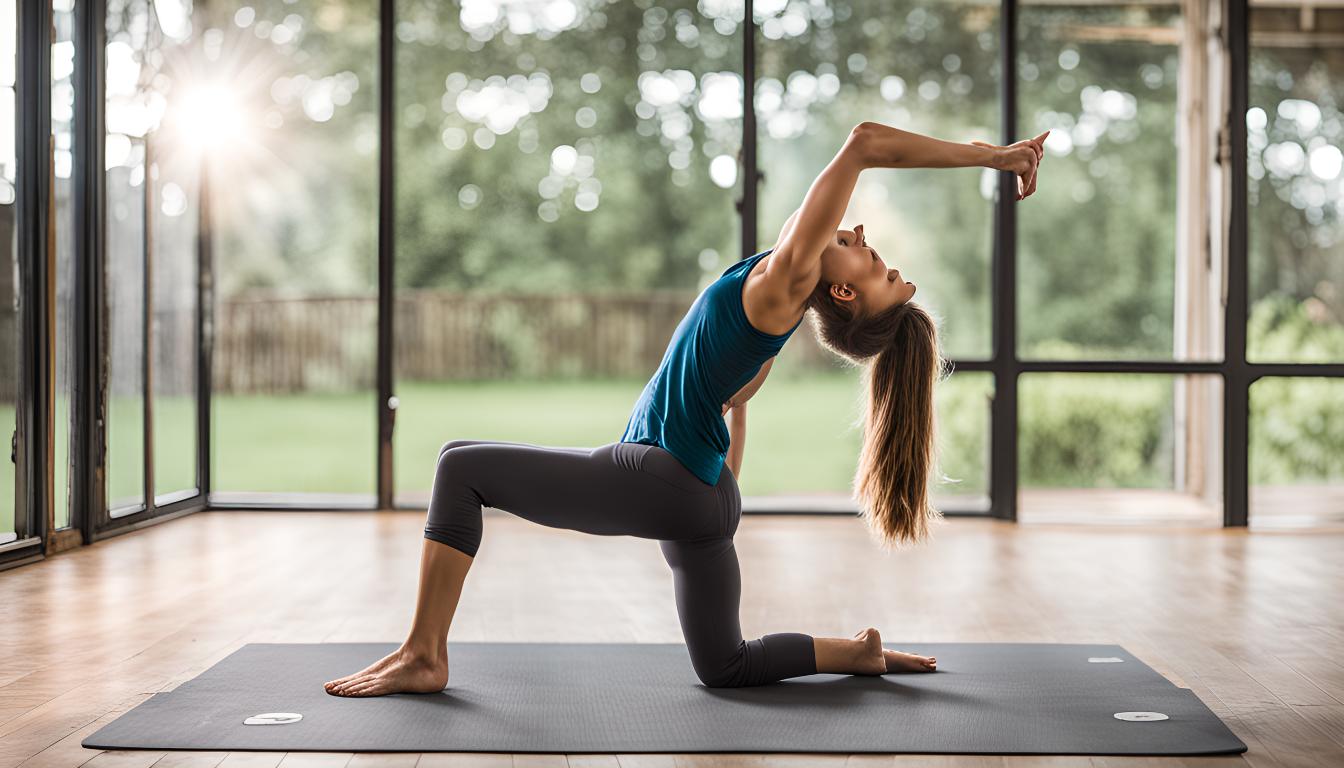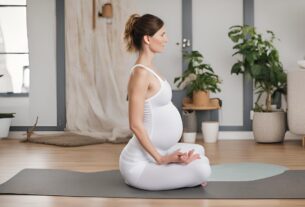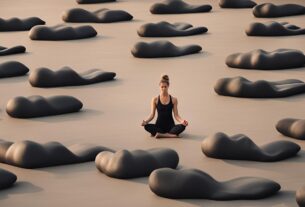Vinyasa Yoga is a dynamic and flowing style of yoga that synchronizes movement with breath, creating a seamless sequence of poses. This practice emphasizes the connection between breath and movement, allowing practitioners to cultivate mindfulness, strength, flexibility, and inner awareness. In a typical Vinyasa class, poses are linked together in a fluid sequence, often referred to as a “Vinyasa flow,” which can vary in intensity and complexity depending on the level and style of the class.
Common Vinyasa Yoga Asanas (Poses)
Sun Salutation A (Surya Namaskar A)
Sun Salutations are commonly used as a warm-up or as part of a Vinyasa flow sequence. They help to awaken the body, build heat, and prepare for deeper asana practice. Sun Salutation A typically includes the following poses:
- Mountain Pose (Tadasana): This is the foundational standing pose where practitioners stand tall with feet together or hip-width apart, grounding through the feet and lifting through the crown of the head.
- Upward Salute (Urdhva Hastasana): Inhaling, lift the arms overhead, palms facing each other or touching, stretching upwards while keeping the shoulders relaxed.
- Forward Fold (Uttanasana): Exhaling, fold forward from the hips, keeping the spine long. Hands can rest beside the feet or on the floor.
- Halfway Lift (Ardha Uttanasana): Inhale, lift halfway up, lengthening the spine, with hands on shins or thighs, creating a flat back.
- Plank Pose (Phalakasana): Exhale, step or jump back to a high plank position, wrists under shoulders, body in a straight line from head to heels.
- Chaturanga Dandasana (Four-Limbed Staff Pose): Lower down with elbows bent, keeping them close to the body, lowering into a low push-up position.
- Upward-Facing Dog (Urdhva Mukha Svanasana): Inhale, press into the hands and feet, lifting the chest and thighs off the mat, with only the hands and tops of the feet on the floor.
- Downward-Facing Dog (Adho Mukha Svanasana): Exhale, lift the hips up and back, forming an inverted V-shape. Feet hip-width apart, heels reaching toward the floor, head relaxed between the arms.
Warrior Poses (Virabhadrasana I, II, III)
Warrior poses build strength and stability in the legs, core, and shoulders while cultivating focus and determination. They are often incorporated into Vinyasa flows for their grounding and empowering qualities:
- Warrior I (Virabhadrasana I): From a high lunge position, back heel rotates down to the mat at a 45-degree angle, front knee bent over the ankle, arms lifted overhead.
- Warrior II (Virabhadrasana II): Open the hips and shoulders to the side, arms extend parallel to the floor, gaze over the front fingertips, front knee still over the ankle.
- Warrior III (Virabhadrasana III): From Warrior I, shift weight onto the front foot, back leg lifts parallel to the floor, torso and arms extend forward in a straight line, balancing on the standing leg.
Balancing Poses
Balancing poses challenge stability, concentration, and alignment, promoting mindfulness and focus:
- Tree Pose (Vrksasana): Standing on one leg, the other foot rests on the inner thigh or calf, hands at heart center or extended overhead like branches.
- Eagle Pose (Garudasana): Cross one thigh over the other, wrap the top foot around the calf, arms cross in front of the body, bending elbows to intertwine forearms.
- Dancer’s Pose (Natarajasana): Standing on one leg, reach the opposite hand back to grasp the lifted foot or ankle, extending the other arm forward, balancing with a slight backbend.
Backbends
Backbends open the front of the body, stretch the spine, and strengthen the back muscles, promoting energy and vitality:
- Cobra Pose (Bhujangasana): From prone position, press palms into the mat, lift the chest while keeping the lower body grounded, shoulders down and away from ears.
- Upward-Facing Dog (Urdhva Mukha Svanasana): Similar to Cobra, but with thighs and shins lifted off the mat, only the tops of the feet and palms on the ground, arms straight.
- Camel Pose (Ustrasana): Kneeling, hips over knees, reach hands back to grasp heels, arch back, lift chest towards the sky, head dropping back if comfortable.
Twists
Twisting poses improve spinal mobility, aid in digestion, and detoxify the body by wringing out tension and toxins:
- Revolved Chair Pose (Parivrtta Utkatasana): From Chair Pose, twist torso to one side, hook elbow outside the knee, hands in prayer or reaching opposite directions.
- Revolved Side Angle Pose (Parivrtta Parsvakonasana): From Warrior II, place one hand on the mat inside the front foot, rotate torso and lift opposite arm toward the ceiling.
- Twisted Lunge (Parivrtta Anjaneyasana): From low lunge, place opposite elbow outside the front knee, twist torso to face the bent knee, extend back leg.
Hip Openers
Hip-opening poses release tension and increase flexibility in the hips, where emotions and stress can accumulate:
- Pigeon Pose (Eka Pada Rajakapotasana): Front knee bent, shin parallel to the front of the mat, back leg extended straight behind, fold forward over the front shin.
- Half Lotus Pose (Ardha Padmasana): From seated, place one foot on opposite thigh crease, with the other leg extended or bent in front of the body.
- Bound Angle Pose (Baddha Konasana): Sitting, soles of the feet together, knees wide apart, fold forward from the hips, maintaining a long spine.

Inversions
Inversions reverse the flow of gravity, offering a different perspective and energizing the body while enhancing circulation and calming the mind:
- Headstand (Sirsasana): Interlace fingers, place forearms on the mat, crown of the head on the ground, lift legs off the mat, extending towards the ceiling.
- Handstand (Adho Mukha Vrksasana): From Downward-Facing Dog, walk hands closer to the feet, kick legs up towards the sky, balancing on the hands.
- Shoulder Stand (Sarvangasana): Lie on the back, lift legs and lower back off the mat, support hips with hands, extend legs towards the sky, shoulders and upper back supporting the weight.
Integration into Vinyasa Flow
In a Vinyasa Yoga class, these asanas are integrated into sequences that flow smoothly from one pose to the next. The transitions between poses are coordinated with the breath, typically using a “one breath, one movement” approach. This continuous flow helps to build heat within the body, improve cardiovascular fitness, and deepen the connection between mind and body.
Variations and Modifications
Vinyasa Yoga is accessible to practitioners of all levels, as poses can be modified or adjusted to suit individual needs. Teachers often offer variations of poses or use props such as blocks, straps, or bolsters to assist students in achieving proper alignment and comfort.
Benefits of Vinyasa Yoga
The practice of Vinyasa Yoga offers a multitude of benefits for physical, mental, and emotional well-being:
- Physical Benefits: Improves strength, flexibility, balance, and cardiovascular health. Promotes detoxification through movement and breath.
- Mental Benefits: Enhances concentration, focus, and mindfulness. Calms the mind and reduces stress through the rhythm of breath and movement.
- Emotional Benefits: Fosters self-awareness and emotional stability. Releases tension and promotes a sense of vitality and energy.
Conclusion
Vinyasa Yoga is not just a physical practice but a holistic approach to wellness that integrates body, mind, and spirit. Through its dynamic and flowing sequences of poses, synchronized with breath, Vinyasa Yoga empowers practitioners to explore their inner landscape while cultivating strength, flexibility, and mindfulness. Whether you are new to yoga or a seasoned practitioner, Vinyasa Yoga offers a pathway to vitality, peace, and self-discovery on and off the mat.
Top of Form
Bottom of Form




